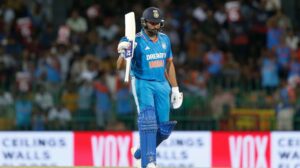
Shamik Chakrabarty in Colombo
Rohit Sharma plays a high-risk game in white-ball cricket these days. He has consciously made the change in his approach it has been yielding high returns.
Rohit’s batting was a reason why India looked so dominant in last year’s World Cup until they fell at the final hurdle. He wasn’t the team’s highest run-scorer in the tournament. Virat Kohli had 765 runs in 11 innings, while Rohit made 597 from the same number of innings. What stood out was his strike-rate, 125.94, which was wonderfully impressive by ODI standards. His batting allowed others to play freely without much pressure. Who knows what would have happened if Rohit had a bit of luck in the final — Travis Head not pulling off a stunner to dismiss him. But that’s water under the bridge now.
Rohit has retired from T20Is. He returned to ODIs after a long time; in the first match of the ongoing series against Sri Lanka. Before that, his last game in this format was the World Cup final on November 19 last year. He hardly took time to get into the groove.
The pitch for the first match was challenging. It was slow and low and the ball was sticking on the surface. Almost every Indian batter struggled and eventually, the team fell short of a victory target of 231. Rohit was an aberration. Not only did he score 58 off 47 balls, but until he was there at the crease, it looked a different game.
Of course, Rohit had the advantage of playing in the first Powerplay and facing the new ball, but his opening partner, Shubman Gill, found it tough to get going. Rohit made the game look easy with the lightness of his touch. “It didn’t look like he had a break (in this format),” Sairaj Bahutule, who is here as the team’s bowling coach, had said at the post-match presser after the first game.
In the second ODI on Sunday, as India chased 241 for victory, the skipper was once again in top fettle. The Premadasa Stadium pitch wasn’t quite as slow and low as the first one, but the ball was turning and Sri Lanka had a spin-heavy attack, with just one seamer in their ranks. Rohit neutered the spin threat early.
Dunith Wellalage troubled India in the first game. Today, Rohit took care of him early, in the fourth over. A couple of gorgeous square cuts accounted for a couple of fours. The left-arm spinner altered his length and bowled full. Rohit brought out the sweep and dispatched the delivery to the backward square-leg boundary.
Akila Dananjaya was brought into the attack and Rohit welcomed him with a four to deep mid-wicket. The Sri Lankan spinners were struggling for control, bowling with the new ball, in the first Powerplay. Rohit’s aggression and precision considerably increased their degree of difficulty.
Medium pacer Asitha Fernando wasn’t spared either. An over-pitched delivery was driven through mid-off. It was the shot of the match. Fernando then bowled a touch short, and Rohit pulled it over the deep square-leg for a six. A maximum off Kamindu Mendis took him to his 57th half-century in ODI cricket. Eventually, when Rohit got out for 64 off 44 balls, trying to reverse-sweep Jeffrey Vandersay and falling prey to an excellent catch from Pathum Nissanka, India had raced to 97 in the 14th over.
Once again, it became a different game after he departed, as Sri Lanka’s spin-punch became effective and India started to lose wickets at regular intervals. Even at 37 years of age, Rohit, along with Kohli, remains India’s best batter across formats. After T20I retirement, there have been speculations over his ODI future, whether the Champions Trophy next year is going to be his last. But as India coach Gautam Gambhir has said, Rohit looks good enough to play until the next World Cup.




